Comparing the Year’s Bests
I recently read six of the year’s bests science fiction/fantasy/horror anthologies. The anthologies were published in 2020 and contain stories originally published in 2019. I’ll refer to the anthologies by their editors.
The Year’s Best Science Fiction Volume 1: The Saga Anthology of Science Fiction 2020 edited by Jonathan Strahan
The Best Science Fiction of the Year Volume 5 edited by Neil Clarke
The Year’s Best Science Fiction & Fantasy 2020 edited by Rich Horton
The Year’s Best Dark Fantasy & Horror: Volume One edited by Paula Guran
The Best Horror of the Year Volume 12 edited by Ellen Datlow
The Best American Science Fiction and Fantasy 2020 edited by John Joseph Adams & Diana Gabaldon
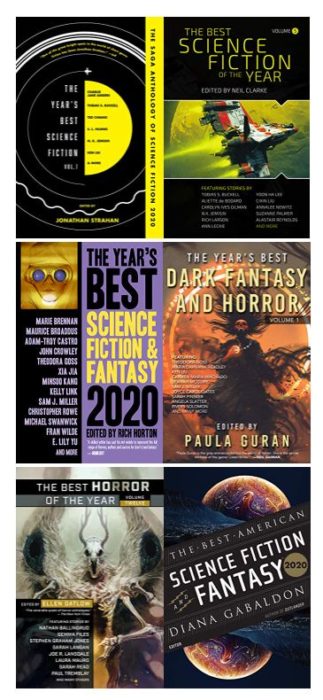
There are more genre stories published in a single year than anyone could possibly read. These anthologies provide a great way to get an overview of the field. The anthologies are defined by the genre they focus on and most of them include an overview of the year in publishing, along with a list of honorable mentions. The Best American series restricts itself to US or Canadian writers or residents. John Joseph Adams serves as series editor and chooses a longlist of 80 stories. The year’s guest editor (in this case Diana Gabaldon) then selects the final stories.
Number of Stories
The anthologies and the number of stories they contain:
| Strahan | 28 |
| Horton | 33 |
| Clarke | 28 |
| Guran | 25 |
| Datlow | 22 |
| Gabaldon and Adams | 20 |
This sums to 156 entries, but since some stories are included in multiple anthologies there are 137 unique stories, reinforcing the idea that best is a subjective criteria. Some authors have multiple stories included, resulting in 124 individual authors. Excluding translated stories, none of the stories are co-written.
Original Publication Sources
The bulk of the stories were originally published in genre magazines and anthologies. For the sake of simplicity I’m including online and print magazines in the same category.
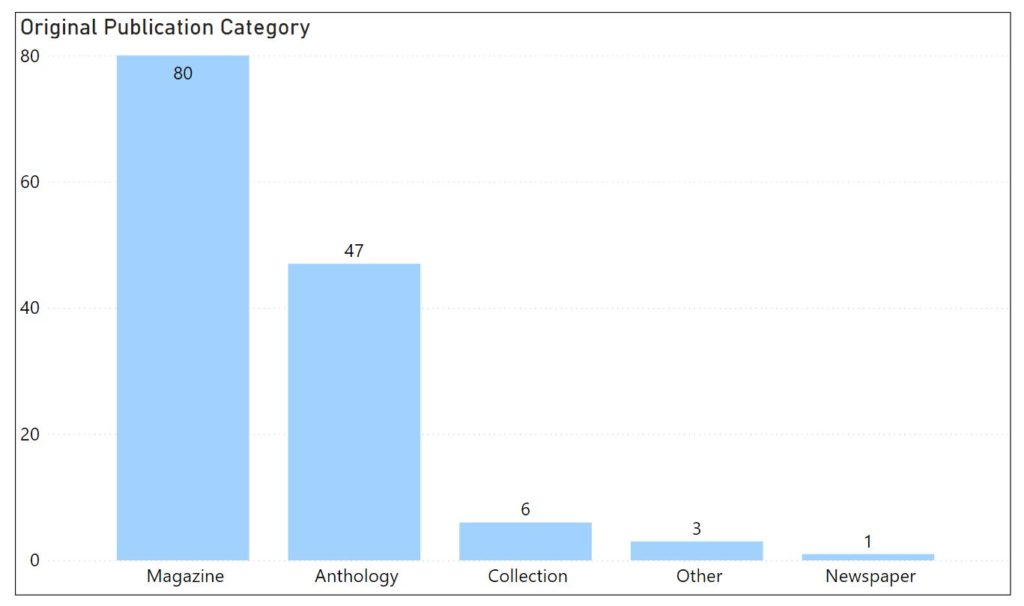
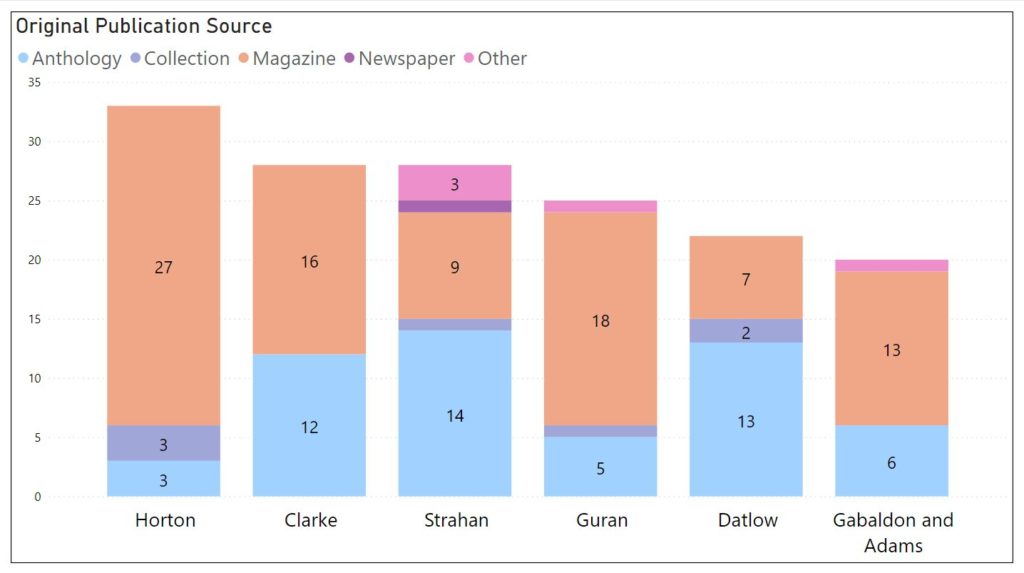
Strahan and Datlow favored stories from anthologies, whereas the other editors relied more on the genre magazines for their selections.
Counting each story once (even if it appeared in multiple year’s bests), The Magazine of Fantasy and Science Fiction (F&SF) has the most stories included, followed by Tor.com, Asimov’s, Clarkesworld, Lightspeed and Uncanny. (And restricting it to sources which have more than 1 story included).
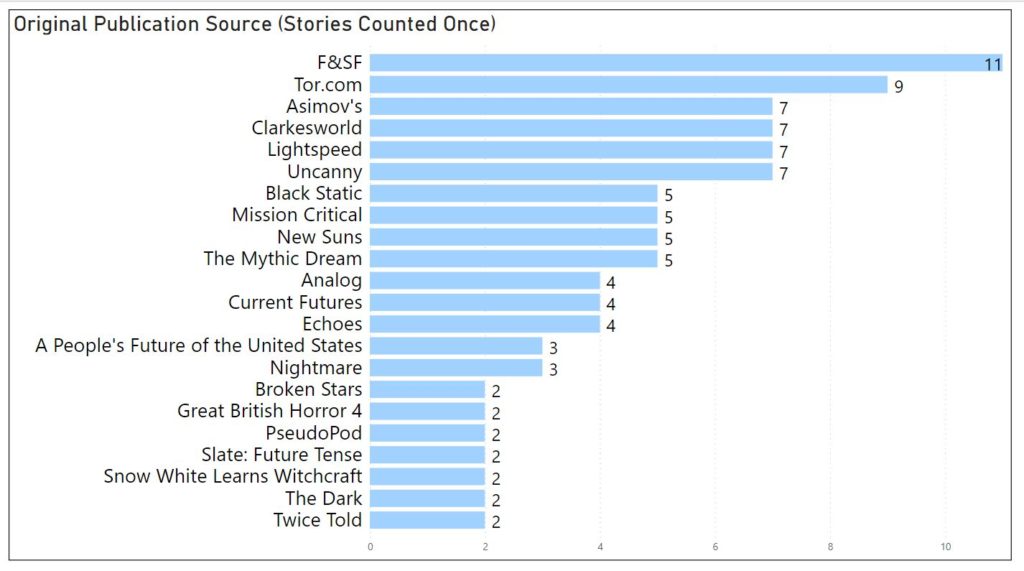
Counting a story multiple times if it appears in multiple anthologies:
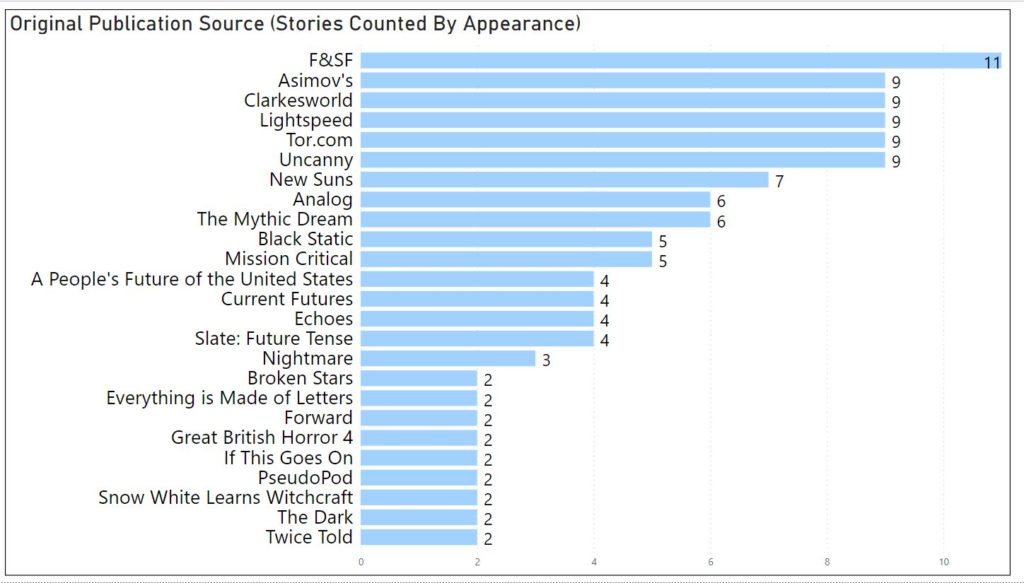
New Suns (which won the World Fantasy Award for Best Anthology), The Mythic Dream and Mission Critical were the most popular anthologies.
Authors
Elizabeth Bear had 4 separate stories published in 2019 which made it into the year’s bests.
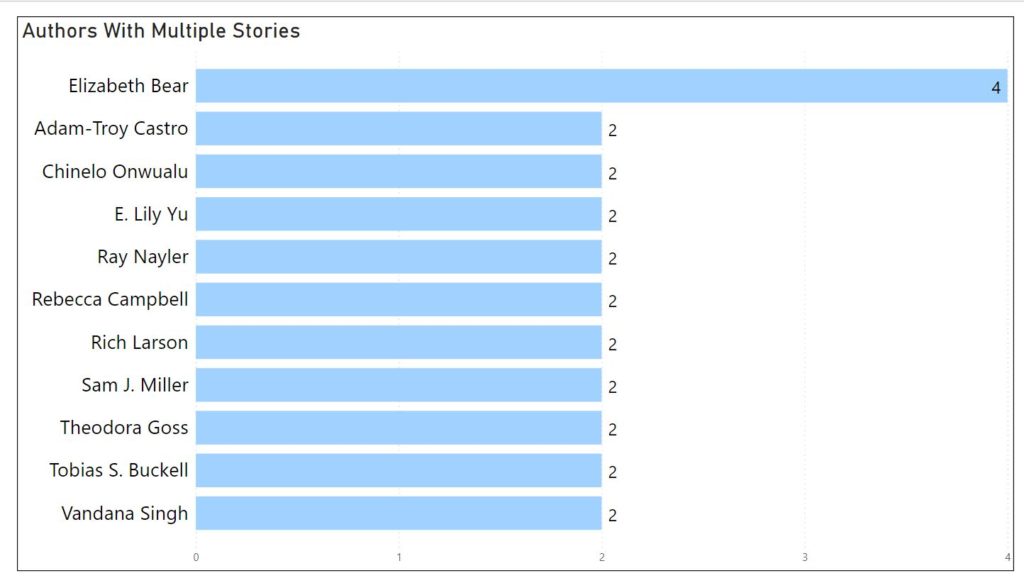
Counting each appearance in the year’s bests, a few other authors managed to appear 3 times.
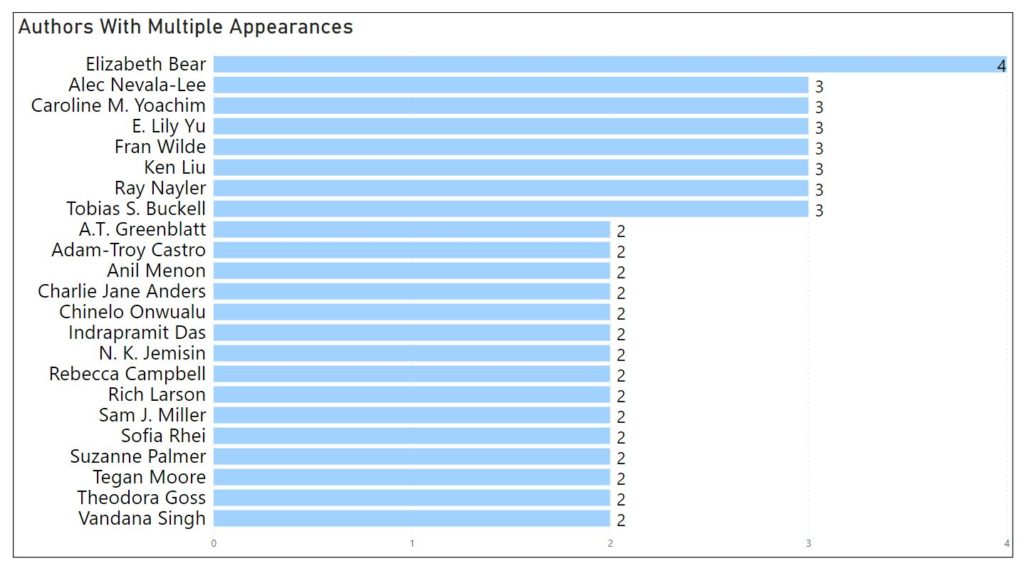
It would be interesting to look at author demographics, but classifications can be a difficult process. Datlow mentions in her introduction that of the 22 contributors in her anthology: “Twelve stories are by men, nine by women, and one by a nonbinary contributor. The authors hail from the United States, the United Kingdom, and Canada. Eleven of the contributors have never before appeared in any volumes of my Best Horror of the Year series.”
Jonathan Strahan suggested looking at the first publication date of the authors and I got the data from ISFDB (which often has omissions when it comes to short fiction listings, but serves as a reasonable basis).
Of the 124 authors included in the anthologies, the average first year of short fiction publication was 2005.
91 (73%) had 2000 or later.
58 (47%) had 2010 or later.
5 authors had their first short fiction publication in 2019 (in most cases it was their first published story which ended up in the year’s best).
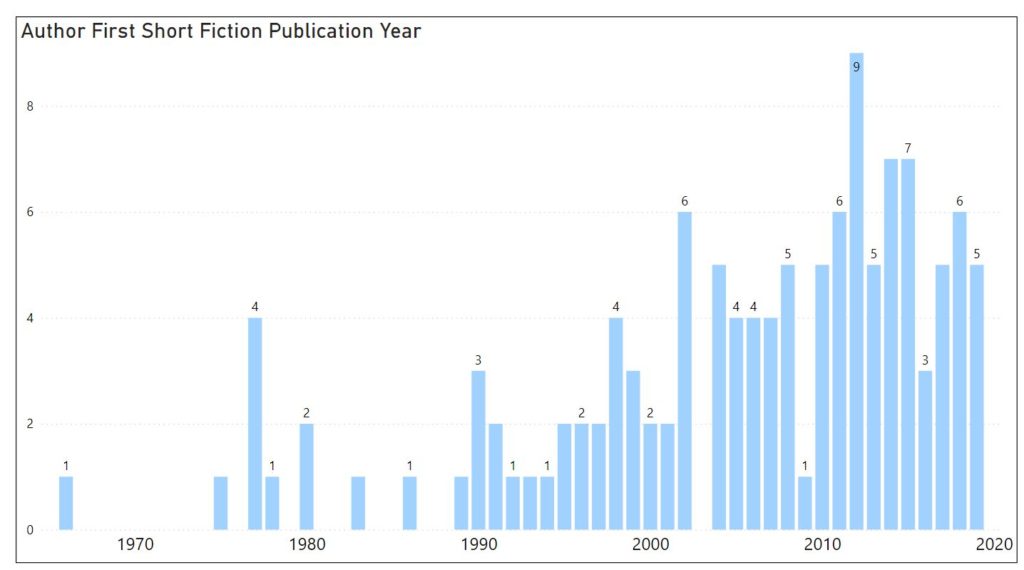
Looking at range of first publication year across the anthologies:
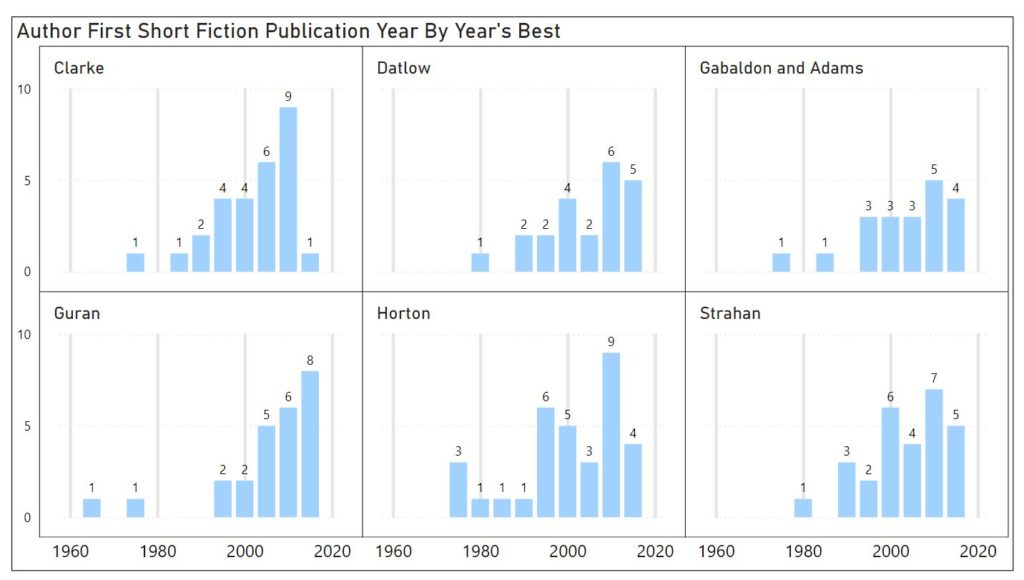
Stories
There are relatively few stories which the editors agreed are the best. Four stories made it into three of the anthologies.
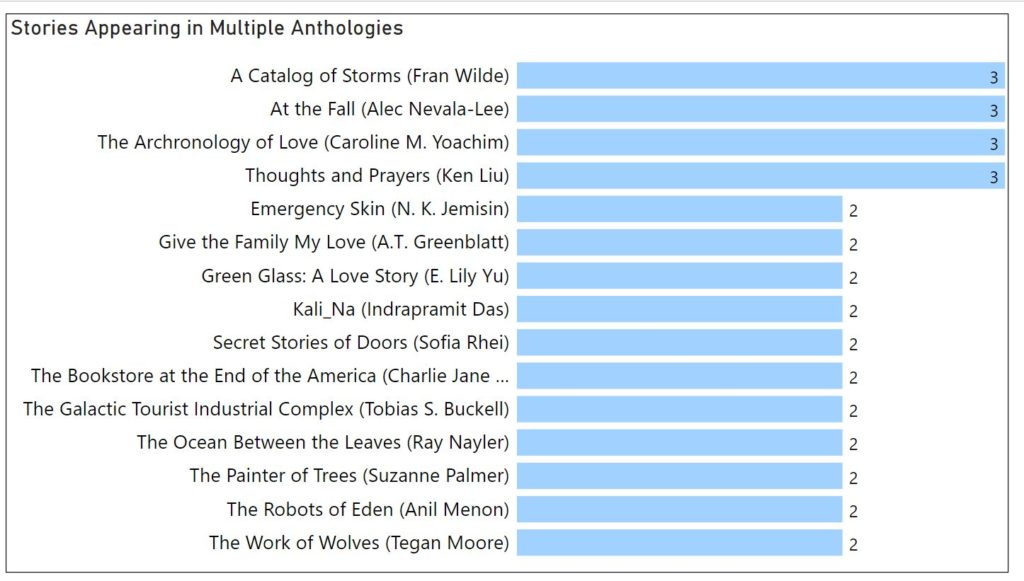
Awards
Major genre award nominations are announced after the editors made their selections, so this doesn’t influence their choices. This is not to suggest anthologies which include more award-nominated stories are necessarily better (it would favor anthologies with more stories and there are more sf/f awards than horror awards), but it’s interesting to see how editorial tastes track with award nominations. Looking at Hugo, Nebula, World Fantasy, Shirley Jackson and Ignyte finalists. None of the anthologies included any Stoker finalists.
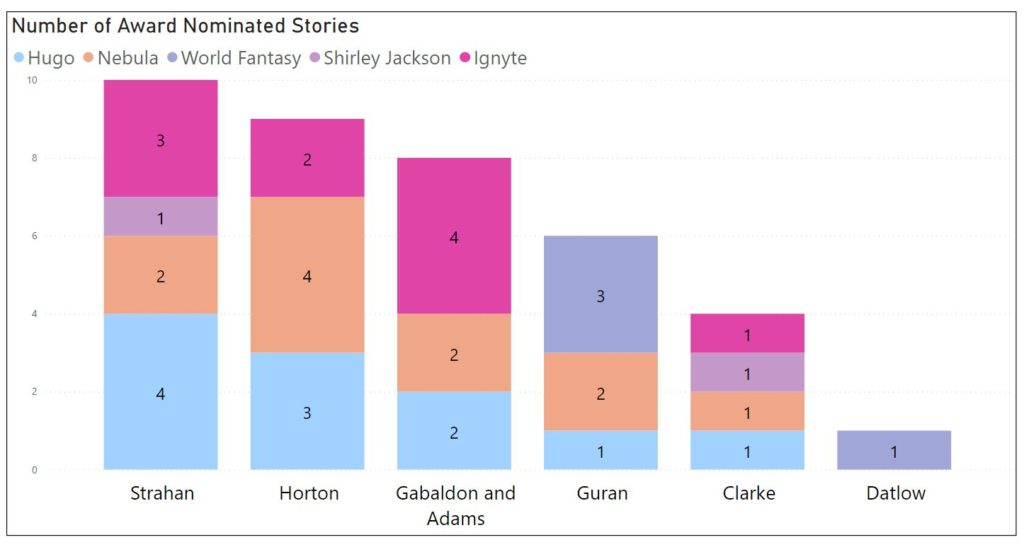
Settings
I only decided to record story setting after I’d finished reading the anthologies, so undoubtedly I’ve made a few mistakes, and of course classifying stories with multiple settings is difficult. Many of the stories I’ve classified as Unknown are probably USA but it isn’t clearly specified. I’ve classified alien planet stories under Space. (As Shiv Ramdas pointed out on Twitter, stories set on Earth are technically set in space too).
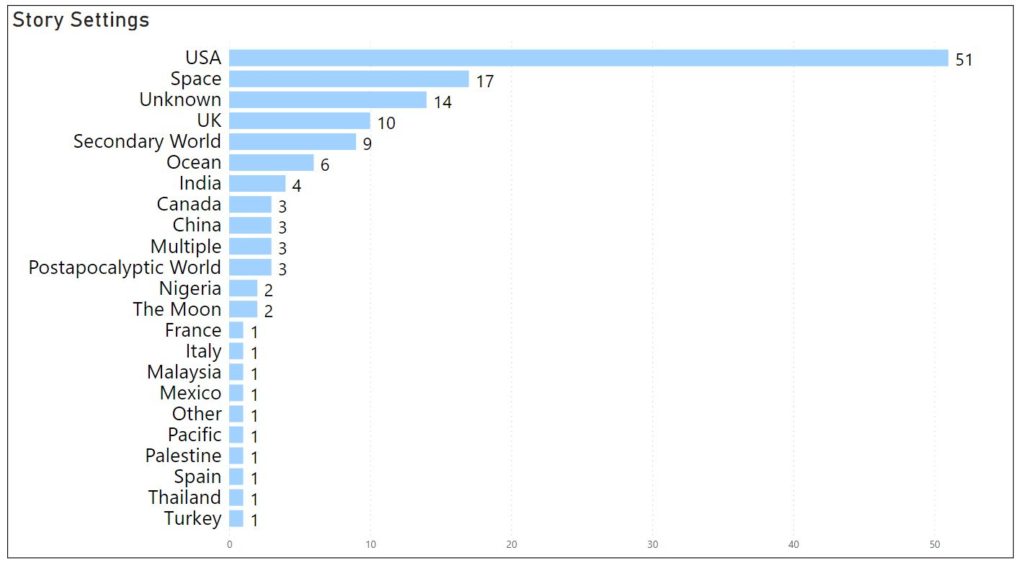
The story settings are more diverse than similar anthologies from 10 years ago, but the USA is still the most common setting. There were a lot of underwater and ocean stories, partly because there are a few stories from Current Futures, an ocean-themed anthology edited by Ann VanderMeer.
There are relatively few secondary world stories compared to contemporary or future earth settings. Epic fantasy can be difficult to write in a short story, but the anthologies did include other novella-length work. There was only one story from Beneath Ceaseless Skies included in the year’s bests, Nghi Vo’s Boiled Bones and Black Eggs.
Point of View
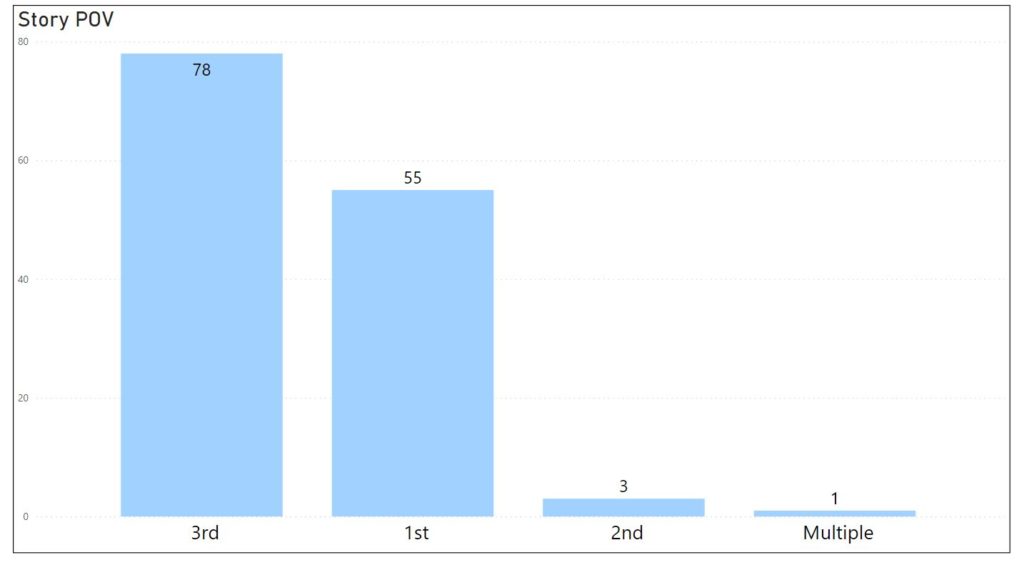
As expected 3rd Person is the most popular choice for point of view. 1st Person isn’t that far behind. There are a few 2nd person POV. (It can sometimes be difficult to distinguish a first person POV where the narrator is addressing someone from a true 2nd person POV). The multiple entry refers to 1st and 3rd person POV in the same story, Maurice Broaddus’ The Migration Suite: A Study in C Sharp Minor.
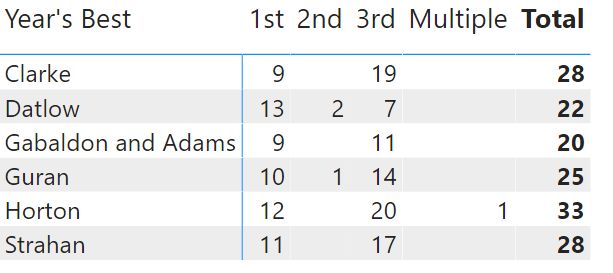
Datlow was the only editor who included more 1st person POV stories than 3rd person.
Word Counts
Many of the editors were kind enough to share their anthology word counts with me. (Paula Guran didn’t have the information on hand). Some of the same stories have different word counts because the editors used different rounding.

SFWA defines story categories as:
1-7499 words: short story
7500 – 17499 words: novelette
17500 – 39999 words: novella
Looking at word counts from 5 of the anthologies, the average word count is 7246, almost novelette length. Clarke had the highest average word count (he only included 2 stories under 5000 words), as well as the longest story, Alastair Reynolds’ Permafrost.
There was only one story under 1000 words in all of the anthologies – Tina Connolly’s miscellaneous notes from the time an alien came to band camp disguised as my alto sax. Flash fiction is difficult to get onto award lists and into year’s bests.
Taking stories from the 5 anthologies (and counting each story only once), this is the breakdown by length category.
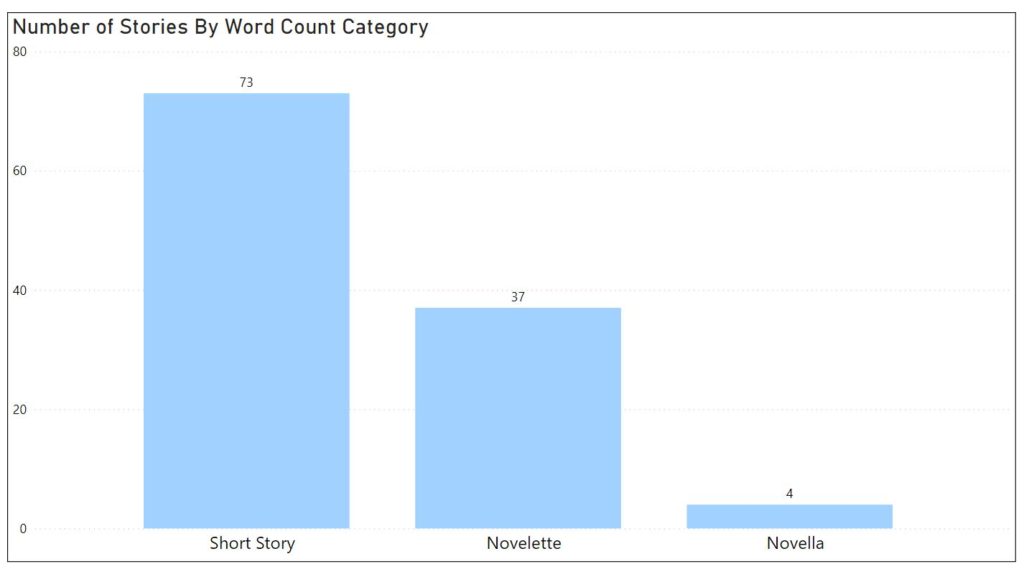
There are fewer markets that publish novelettes, but they are a relatively popular choice for inclusion in year’s bests.
Neil Clarke wrote that his anthology had 13 short stories, 13 novelettes and 2 novellas. This was compared to his previous year’s anthology which had 18 short stories, 11 novelettes and 3 novellas.
This is how the stories are distributed in terms of 1000 word ranges. The range with by far the most stories is 5001-6000 words.
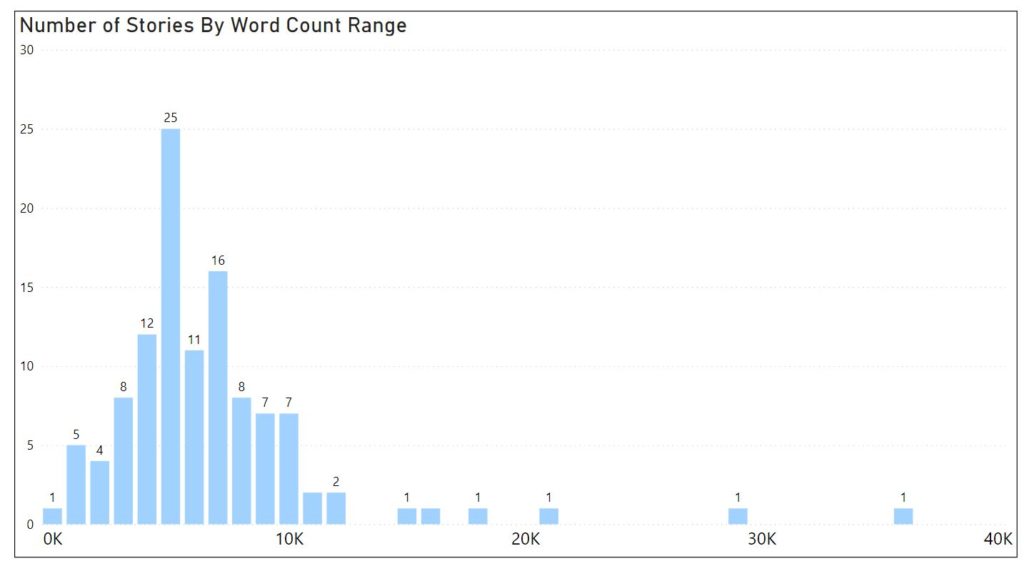
Looking at individual word count for each of the 5 anthologies.
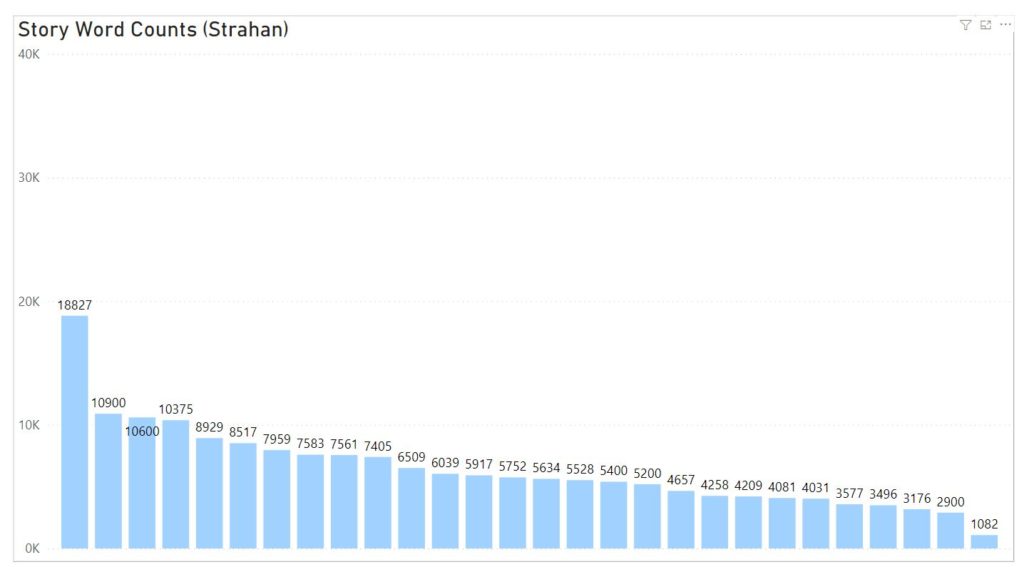
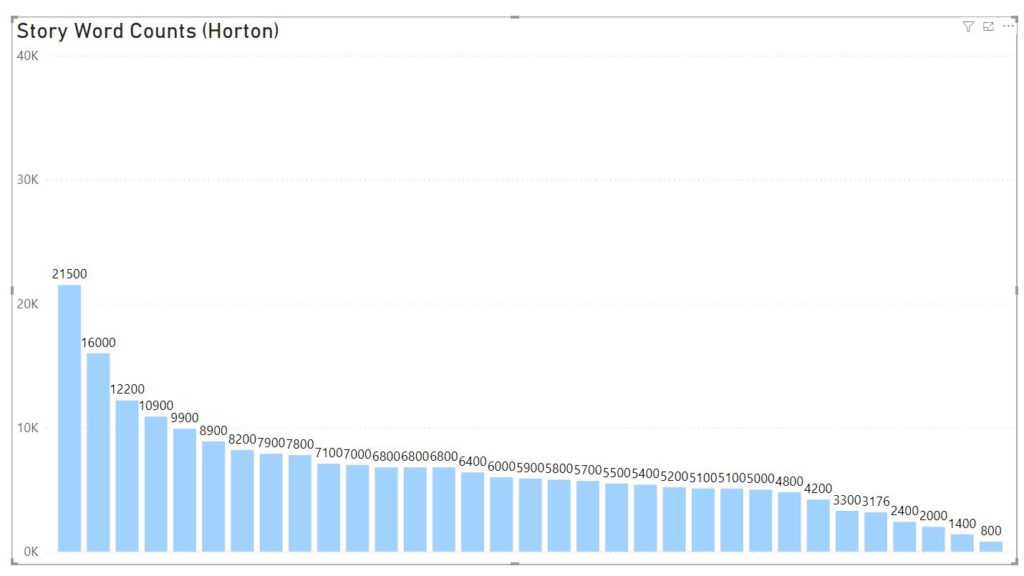
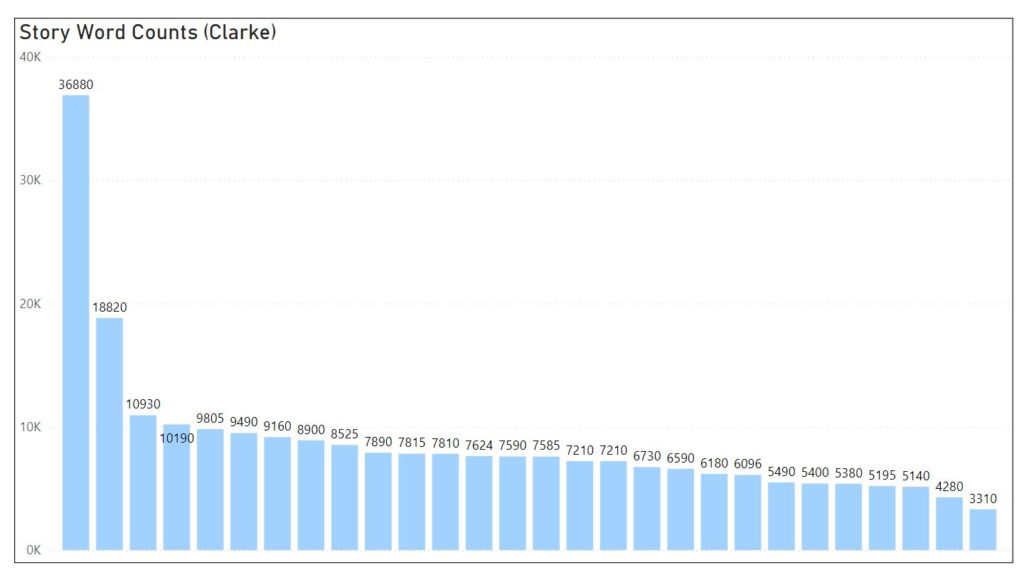
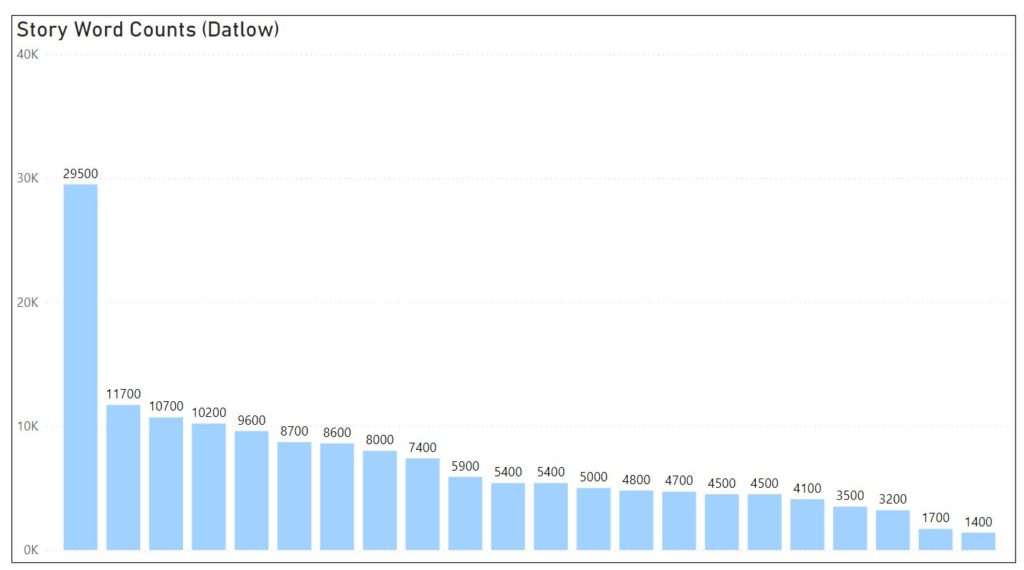
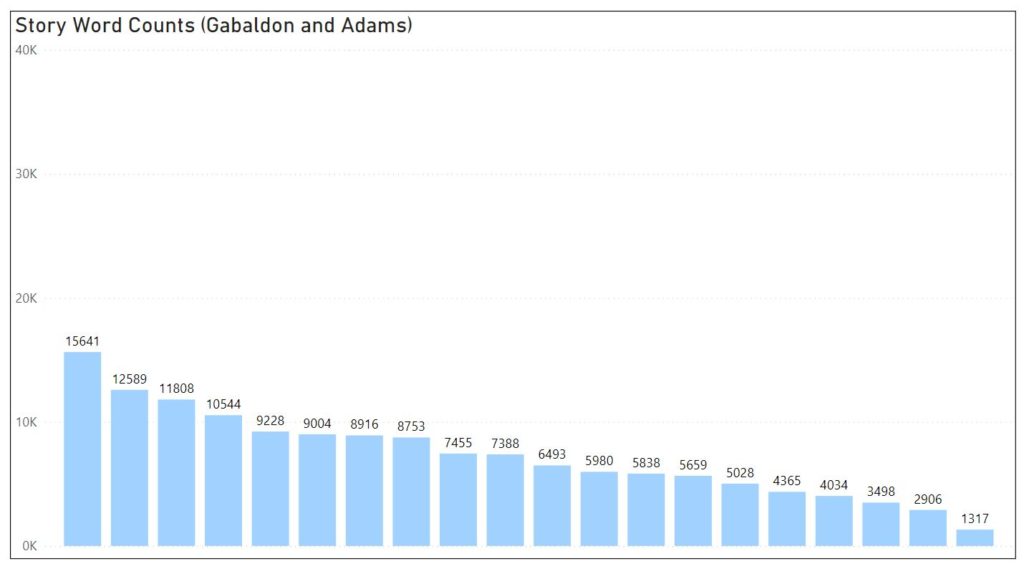
Common Themes
There were a lot of what I’d describe as quiet stories. Background menace stories. Human-caused climate change is bad, rather than space battles are cool stories. Lots of stories set underwater or on ocean-going vessels. There were also a few stories with characters returning to childhood homes or remembering childhood events. There are a few stories dealing with the legacy of colonialism.
Personal Preferences
I’m an impatient reader. There’s so much I want to read that if a story doesn’t grab me early on, I’m not likely to finish it. This means I sometimes miss out on stories I would have loved if I’d given them more of a chance. Occasionally because people keep recommending a story, I’ve gone back and discovered a story I liked. Other times I just don’t like stories that lots of other people love. A lot of it comes down to personal preferences and sometimes what mood you are in when you’re reading a story.
Overall I probably liked about half of the stories in most of the anthologies. The Horton anthology had the most stories I loved (but it also had the most stories) and the Datlow anthology had my highest overall average rating of the stories.
My favorite story from 2019 was Alice Sola Kim’s time loop story, Now Wait for This Week. That was only in one of the anthologies and didn’t make it onto the award lists. Haunt by Carmen Maria Machado packed a lot of emotional impact in a few words. A.T. Greenblatt’s Give the Family My Love won the Nebula and another of my favorites. I also adored Kelly Link’s The Girl Who Did Not Know Fear. Another 2019 favorite was Siobhan Carroll’s For He Can Creep. It was a finalist for the Hugo, Nebula and World Fantasy Awards but wasn’t included in any of the year’s bests.
I would have liked more humorous stories to be included, but that’s an even more subjective measure. Two of the funniest stories are Dominica Phetteplace’s One Thousand Beetles in a Jumpsuit (also my favorite title) and Fonda Lee’s I (28M) created a deepfake girlfriend and now my parents think we’re getting married.
The story which grabbed me the most with a sense-a-wunda feeling was Nathan Ballingrud’s The Butcher’s Table. It’s also one of the darker stories.
The year’s best anthologies are a great way to get an overview of the current state of short fiction. Ideally you’d read all of them, but if you were going to buy just one, which one would it be? One way to choose would be to pick the one which matches your favorite genre. I generally prefer science fiction and fantasy, but I liked the stories in the Datlow horror anthology the best. It’s a matter of finding which editor’s choices most match your preferences. And that can change year to year based on each selection. So it’s probably best if you read all of them.
Links
Links on the editors web sites where they include table of contents and honorable mentions lists.
Neil Clarke Table of Contents
Ellen Datlow TOC
Paula Guran TOC, Honorable Mentions
Diana Gabaldon & John Joseph Adams TOC & Honorable Mentions
Rich Horton TOC
Jonathan Strahan TOC
Easily the best review and round-up of the Years Bests I have ever come across, BRAVO!